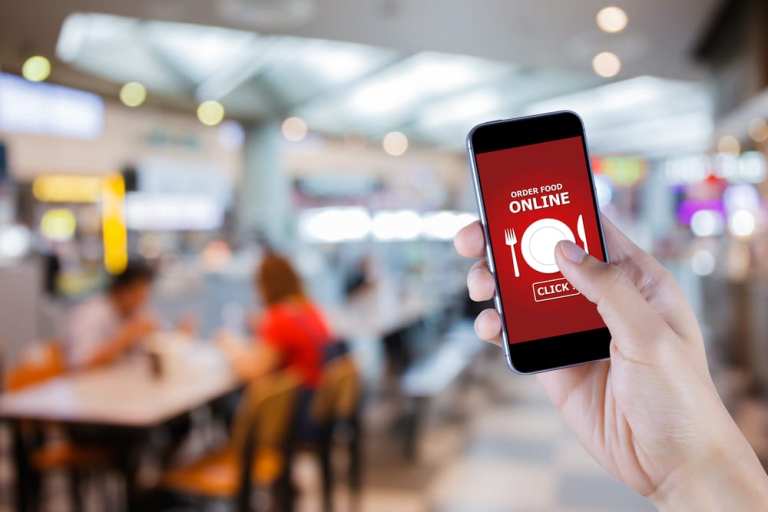How QSRs Are Seizing Mobile Order-Ahead’s Mainstream Momentum

Mobile food ordering has quickly gone from niche activity to mainstream. Between 2016 and 2018, the volume of orders placed through mobile apps grew by 130 percent, according to PYMNTS’ Mobile Order-Ahead Tracker. Mobile represents roughly 60 percent of all digital restaurant orders today. This rapid growth is expected to boost the market’s value to $38 billion by 2020.
Even Google recently introduced the ability to order food for pickup or delivery via services like DoorDash, Postmates and ChowNow through Google Maps.
This change in consumer behavior has implications for the restaurant industry and beyond. Mobile doesn’t just mean apps – order-ahead technology is also increasingly being integrated into cars, and the rise in mobile ordering is affecting restaurants themselves. Some have been physically restructuring to accommodate mobile order pickup without estranging in-person customers.
Restaurant operators are aware it’s not just good business to give consumers what they want – it’s also about staying ahead of the competition: 59 percent said they faced disruption from competitors that embraced mobile order-ahead technology.
Most food establishments are taking one of two paths: a proprietary app or partnering with a third-party ordering platform.
The Mobile Order Ahead Tracker published its monthly Scorecard, ranking restaurants on a scale of zero to 100 on factors like ordering channels, loyalty integrations and app users. This month, Starbucks came out on top with a score of 96, followed by Domino’s, Chick-fil-A and Pizza Hut. The top four were all branded apps, which makes sense for large chains.
Mobile order-ahead apps have lower adoption among smaller QSRs. PYMNTS’ most recent Restaurant Readiness Index found that only 30.7 percent have mobile apps for ordering, while 31.7 percent offer services via third-party apps. However, most restaurants are satisfied with mobile order-ahead pickup offerings. In fact, 91.4 percent of small QSR managers were satisfied, according to the Mobile Order-Ahead Tracker. Additionally, 86 percent of mobile app operators said their offerings boosted revenues, and 93 percent said apps improved guests’ experiences and encouraged repeat purchases.
Yum Brands!, which operates the Pizza Hut, Taco Bell and KFC chains, went the partnership route with Grubhub while maintaining a standalone app for Taco Bell. Yum even bought a 3 percent stake in Grubhub last year. The QSR has offered order-ahead capabilities on its proprietary app since September of 2015, but the Grubhub partnership allows Taco Bell to reach a larger audience, participate in exclusive sales and promotions and gain access to the delivery service.
Coffee chain Dunkin’ partnered with DoorDash for delivery a few years ago, but has since started using Grubhub while focusing efforts on its own in-app mobile order-ahead capabilities. Dunkin’ CEO David Hoffmann said in a Q4 2018 earnings conference call that mobile orders make up 3 percent of transactions.
Mobile is affecting physical locations, as Dunkin’ has been rolling out “Next-Gen” stores throughout the U.S., which feature dedicated pickup stations and digital status boards that let customers track their orders in real time.
Despite big investments by major chains, independent businesses have also been testing mobile order-ahead services. Seattle-based startup Joe Coffee built a platform to enable customers of local coffee shops to pre-order and pay for their drinks on mobile devices.
Washington, D.C.-based fast-casual pizzeria &pizza has concentrated its efforts on an in-house mobile order-ahead app, aiming to have more control over the ordering experience and to reflect the brand’s quirky in-store experience rather than presenting a generic ordering experience.
“I don’t think you want a guest to have a really unique and interesting experience in person and then feel like they’re talking to some corporation on the digital ordering side,” said Kevin Blesy, &pizza’s head of strategy, in an interview with PYMNTS.
Security was a priority when designing the app, which is pertinent considering there has been a 117 percent increase in the number of mobile device attacks over the past year, according to the Mobile Order-Ahead Tracker.
The chain partnered with Stripe for payment processing, and the app uses the same cloud-based point-of-sale system as it does in its physical locations.